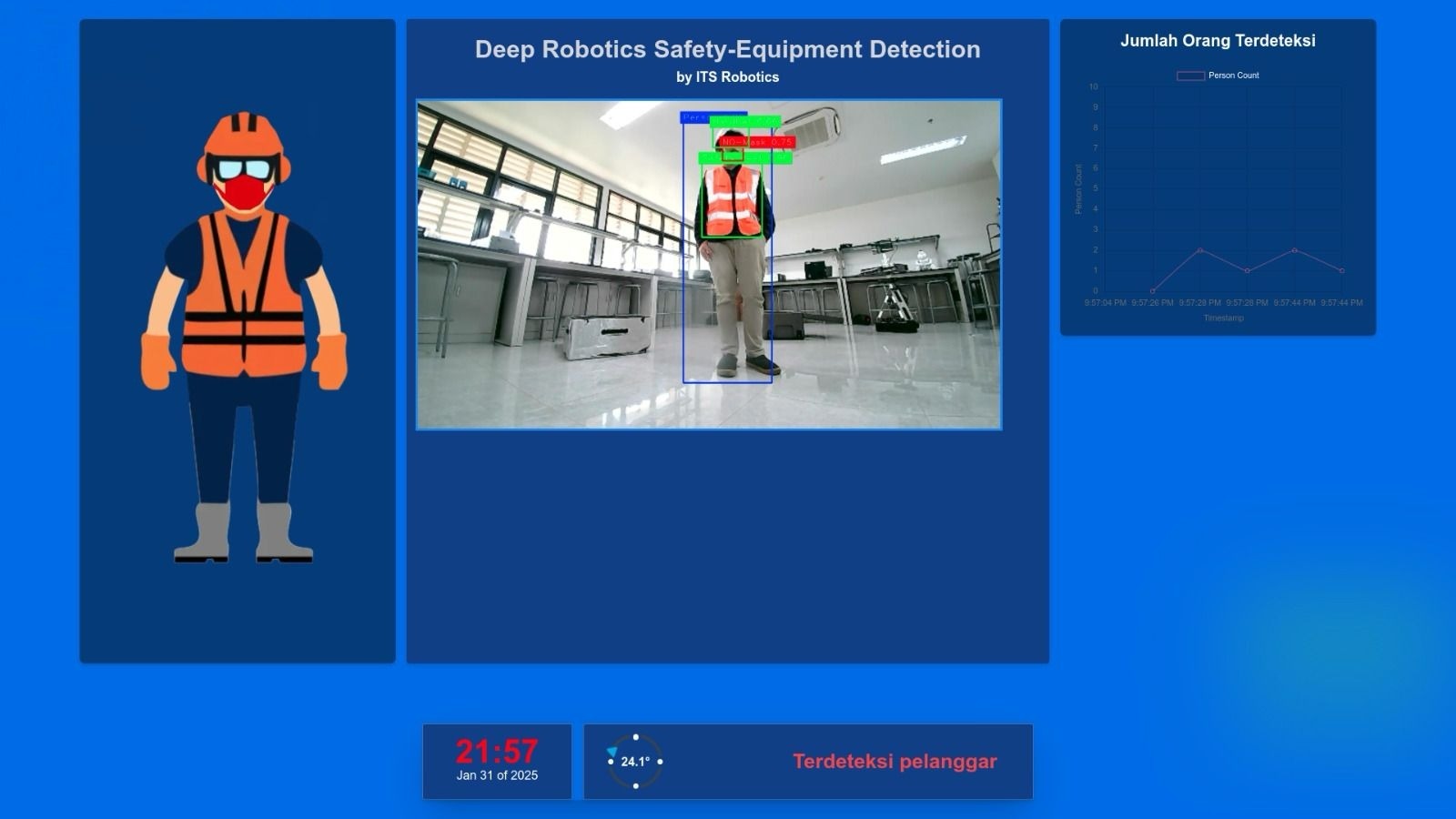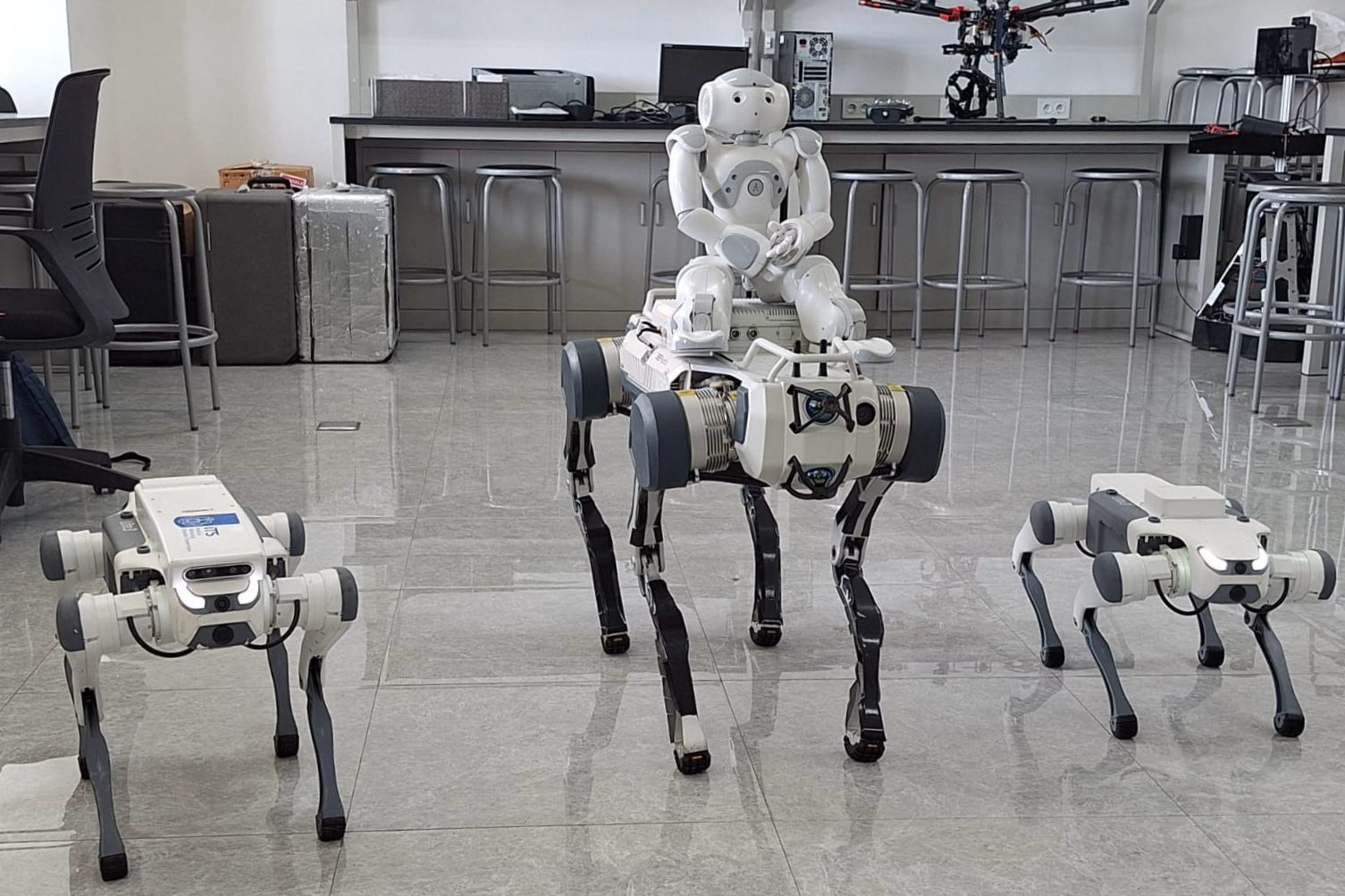ITS Develops Four‑Legged Dog Robot with Sensors and Navigation
The Four-Legged Dog Robot developed by the ITS Robotics Team in collaboration with Ezra Robotics to answer the needs of industry and society.
ITS Campus, ITS News – Institut Teknologi Sepuluh Nopember (ITS) is further solidifying its role in robotic technology by developing a Four‑Legged Dog Robot integrated with sensor, navigation, and artificial intelligence (AI) systems. This robot is capable of moving autonomously, inspecting industrial areas, and receiving verbal commands.
This innovation is the result of collaboration between the Information and Communication Technology (ICT) Cluster and Robotics through ITS’s Science and Technology Center (PUI) for Artificial Intelligence for Healthcare and Society, the ITS Department of Computer Engineering, and Ezra Robotics. The robot, which currently has basic capabilities and was imported from China by Ezra Robotics, has been further developed by the ITS Robotics Team to enhance its sensor, mobility, and autonomy capabilities.
ITS Robotics Team Coordinator Muhtadin, ST MT, explained that one of the main focuses of this robot’s development is as an autonomous patrol unit in industry. The robot is designed to be able to map its environment, detect overheating equipment, and identify anomalies in industrial areas such as electrical substations. “These capabilities are supported by infrared temperature sensors, acoustic sensors, as well as Lidar‑based and Global Positioning System (GPS) navigation,” he explained.
Not only that, Muhtadin continued, this white robot is equipped with deep‑learning‑based intelligence. This capability enables automatic recognition of both additive‑color and thermal image models. “This feature allows the robot to conduct routine independent inspections—such as patrolling substations every three hours—while simultaneously sending observation data to the control center,” the ITS Department of Computer Engineering lecturer elaborated.

ITS Robotics Team Coordinator Muhtadin ST MT, checking the Four-Legged Robot Dog for testing
The ITS electrical engineering alumnus revealed that in terms of mobility, this four‑legged robot can adapt to various types of surfaces, such as rocky terrain and climbing stairs. This makes it superior in stability and flexibility compared to wheeled robots. In addition, the robot also has a manual control feature using a remote control for cases where it is necessary for safety.
Beyond the industrial field, the development of this robot can be applied to disaster response and household sectors. With support from Google Gemini’s Large Language Model (LLM), the robot can receive commands in natural language and then translate them into real actions. “We have also equipped the robot with natural interaction skills to assist daily life,” Muhtadin added.
Furthermore, the robot—which consists of two small robots with a height of 45 centimeters and one large robot with a height of 71 centimeters—is capable of autonomous movement, ranging from walking and running to jumping over various terrains. According to Muhtadin, the relatively different sizes of the robots can be adjusted to needs. “The small robot can be used for domestic needs, while the large robot for industry,” he said.

One of the sensor capabilities of the robot is to detect the completeness of Personal Protective Equipment (PPE) for workers in industry.
In the future, the robot will be commercialized and developed to support various needs in other industrial sectors such as mining and oil and gas. Additionally, ITS will continue to conduct real‑environment implementation tests of the robot to improve the accuracy of its capabilities. “We will develop robot variants with special specifications according to the needs of other sectors to help the community’s life,” Muhtadin said optimistically.
The development of this four‑legged dog robot is also part of ITS’s efforts to support the achievement of the Sustainable Development Goals (SDGs), particularly Goal 9 on Industry, Innovation, and Infrastructure and Goal 11 on Sustainable Cities and Communities. Through this technological innovation, ITS contributes to creating technology‑based solutions that can enhance safety, industrial efficiency, and strengthen community resilience to disasters. (ITS PUBLIC RELATIONS)
Reporter: Aghnia Tias Salsabila
Related News
-
ITS Formulates Inclusive Education System Policy for Students with Disabilities
ITS Campus, ITS News — The Sepuluh Nopember Institute of Technology (ITS) has once again demonstrated its commitment to
May 07, 2025 19:05 -
ITS Develops Andal App, a Solution for MSMEs to Manage Inventory
ITS Campus, ITS News — Amidst rapid technological advancements, many Micro, Small, and Medium Enterprises (MSMEs) still rely on
May 07, 2025 19:05 -
Consolink, an Automatic Soil Consolidation Testing Solution Created by ITS Students
ITS Campus, ITS News — A collaboration between a team of students and lecturers from the Sepuluh Nopember Institute
May 07, 2025 19:05 -
Supporting Economic Empowerment, ITS Signs MOU with BSI
ITS Campus, ITS News — The Sepuluh Nopember Institute of Technology (ITS) continues to strengthen its tangible and sustainable
May 07, 2025 19:05

